Genus Lepisiota (Mayr)
(previously Acantholepis
Mayr, 1861: 42)
Genus
Introduction in Ants of Africa
In Tribe PLAGIOLEPIDINI.
Diagnostic Features - Antennae 11-segmented. Eyes well
developed, ocelli present but may be reduced. Mandibles with the apical
margin oblique and dentate, overhung by clypeus. Alitrunk constricted
in the mesonotal region, the propodeum swollen and bidentate or
bituberculate. Petiole a scale with the dorsal margin bispinose,
bidentate or emarginate. Acidopore borne on a conical projection of the
hypopygium, surrounded by a fringe of hairs.
|
The evidence at present for this area is for the existence of two
species-groups -
note the early authors mostly used two "species" -"capensis" and
"frauenfeldi". The capensis species had a petiole which
was bidentate not bispinose. True Lepisiota
capensis (from South Africa)
is black with sparse erect black hairs. Some of the confusion may stem
from Forel (1892a: 43) where his key had - capensis (from South
Africa, Madagascar and Indian continent) with "erect pilosity whitish,
abundant on body, none on tibiae and scapes". also "petiole scale
narrow with two short spines" - This clearly was erroneous in both
those aspects.
Note - the diagnosis and separation of the carbonaria-group
species is somewhat speculative, as the many of original descriptions
are minimal separations of "subspecies". The efforts of Collingwood,
later with Agosti, are admirable but the papers again give fairly
minimal information and their separations also seem to owe more than a
little to informed guesswork. Some species are included for comparison
with those now known from Egypt, e.g L. simplex and L.
incisa. The "frauenfeldi page deliberately is wide-ranging
because of the poor, confused state of the knowledge.
|
frauenfeldi-group
- elongated, shiny species; with long antennae and legs; propodeum and
petiole usually with sharp prominences or spines; plus reduced or no
pilosity and little pubescence
"frauenfeldi"
- see analysis page, an attempt to sort out a taxonomic mess and
with details opaciventris described from Egypt, and, on
separate pages, Lepisiota
aegyptiaca new status; Lepisiota
gracilicornis, Lepisiota
nigra, Lepisiota
splendens; and Lepisiota syriaca.
The type form is not known from Egypt.
From Tunisia also Lepisiota ajjer separated by
its contrasting yellow-orange appendages
|
 |
| carbonaria-group - stockier
species, duller in appearance due to dense sculpturation; mostly TL
2.0-2.5 mm; propodeum with rounded or blunt prominences and petiole
without spines; shorter antennae and legs; plus substantial coarse
pilosity and dense variably coarse pubescence |
 |
Lepisiota frauenfeldi species-group
|
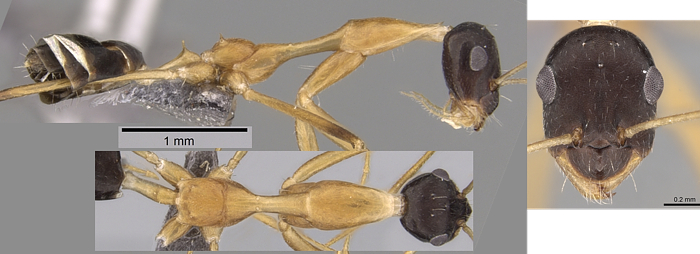 Bizarre and uniquely elongated species; TL 4.25-4.60 mm; HL 0.80-0.82, HW 0.46-0.61, SL 2.0; SI 444. Bizarre and uniquely elongated species; TL 4.25-4.60 mm; HL 0.80-0.82, HW 0.46-0.61, SL 2.0; SI 444.
United Arab Emirates (Collingwood & Van Harten, 2011: 64, in Collingwood et al, 2011)
|
elegantissima
|
| 1 |
Slender elongated species with very long
antennae, SI at least 175, and legs |
2 |
| -- |
Stocky and less elongated with shorter
antennae,
SI ca 150, and legs |
4 |
| 2 |
 SI ca 230; almost
completely black, except for scapes,
mandibles and lower legs SI ca 230; almost
completely black, except for scapes,
mandibles and lower legs |
gracilicornis |
| -- |
SI < 200 |
3 |
| 3 |
 TL 2.3 mm; with
relatively long, narrow head (cf frauenfeldi)
upper marging of petiole weakly incised (less than frauenfeldi);
SI ca 175 (photographed specimens) TL 2.3 mm; with
relatively long, narrow head (cf frauenfeldi)
upper marging of petiole weakly incised (less than frauenfeldi);
SI ca 175 (photographed specimens) |
aegyptiaca
new status |
| -- |
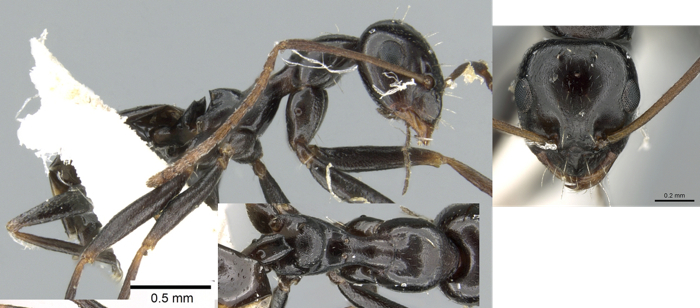 TL 2.5 mm; scapes long SI >190; petiole
narrow, very shiny; propodeum with distinct spines; brown-black,
appendages more brown TL 2.5 mm; scapes long SI >190; petiole
narrow, very shiny; propodeum with distinct spines; brown-black,
appendages more brown |
Questionable record from
Egypt
- splendens |
--
|
Damaged type worker from
Saudi Arabia; separated (Collingwood & Agosti, 1996: 363) as SI
200-205; dorsum of alitrunk and gaster without erect hairs - appears
almost identical to splendens
|
riyadha
|
| 4 |
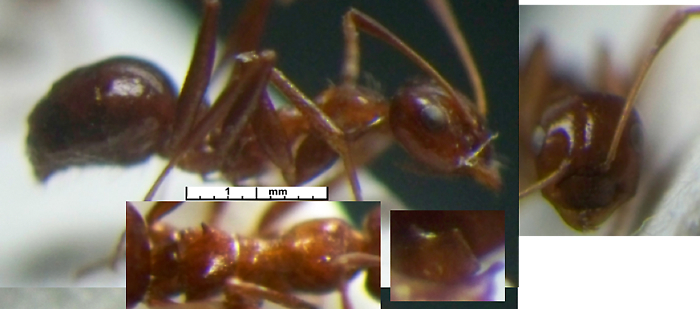 TL 2.0-3.2 mm;
petiole scale wide & acutely dentate;
propodeum with short teeth about than 0.5 X basal space; clypeus with
weaker median carina; less shiny but finely and distinctly reticulate;
alitrunk black with no more than mesonotum red; SI ca 150 (photographed
specimens & Finzi drawing) TL 2.0-3.2 mm;
petiole scale wide & acutely dentate;
propodeum with short teeth about than 0.5 X basal space; clypeus with
weaker median carina; less shiny but finely and distinctly reticulate;
alitrunk black with no more than mesonotum red; SI ca 150 (photographed
specimens & Finzi drawing) |
syriaca |
--
|
 TL , HW 0.61, SL 0.95, SI 153 ; slightly bicoloured yellow-brown; propodeal and petiole spines sharp TL , HW 0.61, SL 0.95, SI 153 ; slightly bicoloured yellow-brown; propodeal and petiole spines sharp
Saudi Arabia, Dammam
Collingwood & Agosti (1996: 366) gave the head as "brilliant black"
- which is not the case with either of the specimens on Antweb - see https://www.antweb.org/specimenImages.do?code=casent0906337
The label dates "March-April '79" differ from the type information of 5.i.79, location and collector the same.
|
dammama
|
--
|
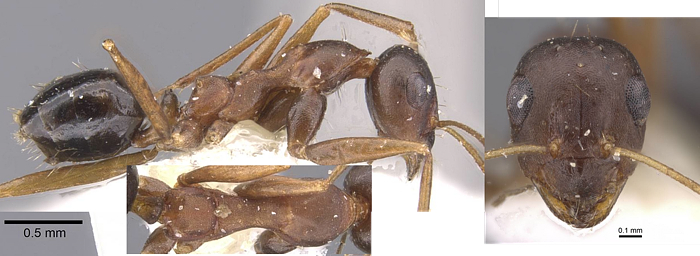 TL 3.0-3.5 mm; dark red-brown; petiole scale high but fairly narrow, acutely dentate TL 3.0-3.5 mm; dark red-brown; petiole scale high but fairly narrow, acutely dentate
Aghanistan, Saroubi
|
kabulica
|
| -- |
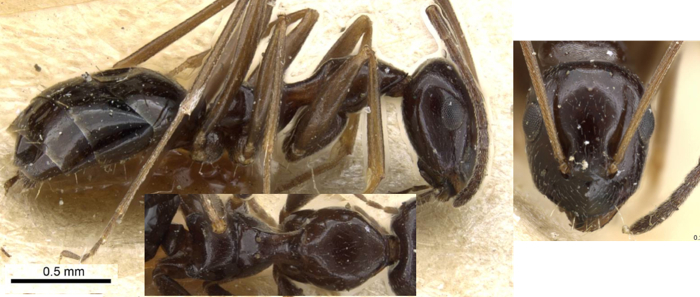 Black specimens from
desert areas with workers TL 2.8-3.0
mm, possibly alternatively identifable as bipartita, which
remains as a subspecies of frauenfeldi (see above). In his key,
Finzi (1936: 188) noted - petiole scale large (bipartita type);
maximum width at about about double the depth of the incision of the
scale. Agosti & Collingwood (1987b: 279, in key) separated nigra
from frauenfeldi as the former being wholly black with a smooth
pronotum; whereas the latter has "part of body usually with a small
patch of red, pronotum sculptured". Black specimens from
desert areas with workers TL 2.8-3.0
mm, possibly alternatively identifable as bipartita, which
remains as a subspecies of frauenfeldi (see above). In his key,
Finzi (1936: 188) noted - petiole scale large (bipartita type);
maximum width at about about double the depth of the incision of the
scale. Agosti & Collingwood (1987b: 279, in key) separated nigra
from frauenfeldi as the former being wholly black with a smooth
pronotum; whereas the latter has "part of body usually with a small
patch of red, pronotum sculptured". |
Questionable record from
Egypt
- nigra |
--
|
 TL
2.80, HL 0.61, HW 0.57, SL 0.70; very short propodeal spines but long
petiole spines; head fringed with short suberect pubescence TL
2.80, HL 0.61, HW 0.57, SL 0.70; very short propodeal spines but long
petiole spines; head fringed with short suberect pubescence
|
harteni |
--
|
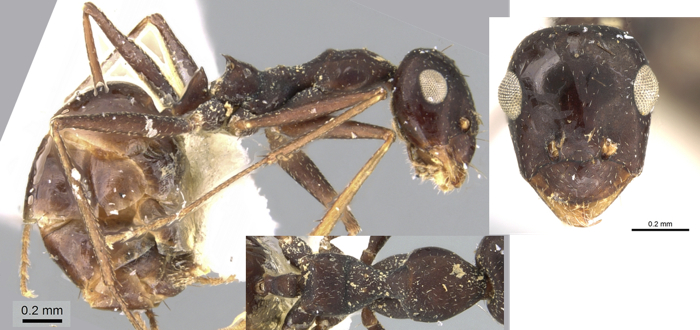 Holotype only; HW 0.60, SL 1.05, SI 175; densely sculptured and opaque; propodeal spines long but petiole spines short Holotype only; HW 0.60, SL 1.05, SI 175; densely sculptured and opaque; propodeal spines long but petiole spines short
Oman
|
dhofara
|
Lepisiota carbonaria species-group
Collingwood's (1985) separation of the carbonaria-group,
with some points and measurements from Collingwood & Agosti (1996),
and additional material on African species gives the following (the
links are to individual species pages) -
Species with the head and gaster sculptured
| 1 |
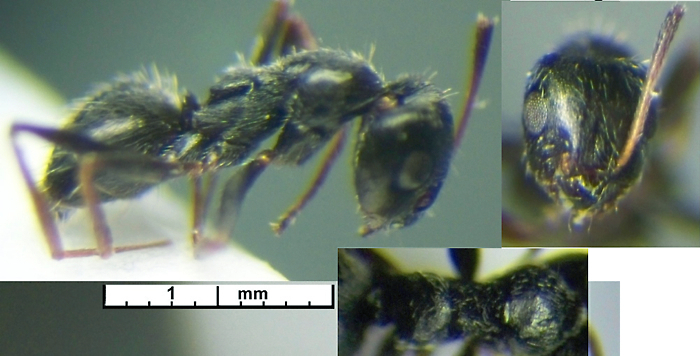 HW 0.61-0.62 SI 116-118 HW 0.61-0.62 SI 116-118
Propodeum profile flat with junction of dorsum and declivity an acute
angle but without teeth or spines; erect hairs sparser and shorter,
gaster with spare pubescence; overall
appearance duller; eyes flatter and appear dull; perhaps slightly
redder in colour with more distinctively contrasting mandibles,
seemingly always visible
|
obtusa
|
| -- |
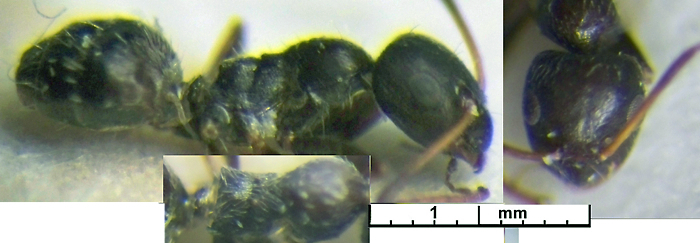 Petiole rounded with very
shallow emargination; propodeum with blunt projections only; whole body
sculptured and dull; alitrunk entirely without dorsal hairs; HW
0.57-0.58 SI 107 Petiole rounded with very
shallow emargination; propodeum with blunt projections only; whole body
sculptured and dull; alitrunk entirely without dorsal hairs; HW
0.57-0.58 SI 107
Base colour dark red-brown; head in full face view heart shaped, erect
hairs short and not obviously distinctive; overall appearance only
weakly shiny, due to a visibly shagreened (roughened) surface
|
erythraea |
| -- |
Dorsal hairs on alitrunk sparse, mainly
restricted to pronotum or nil |
2 |
| 2 |
Petiole angles produced into long spines |
3 |
| -- |
Petiole emarginate or dentate at most |
4 |
| 3 |
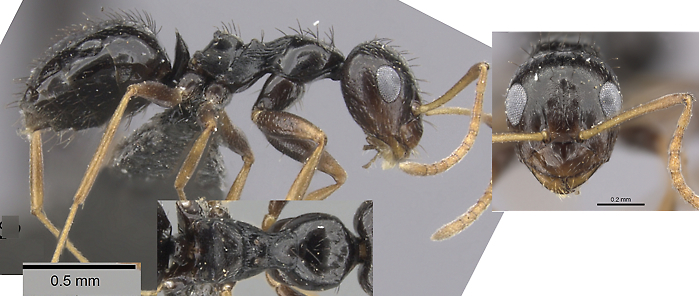 Petiole spines longer than their intervening width; HW
0.57-0.57 SI 105-107 - for comparison Petiole spines longer than their intervening width; HW
0.57-0.57 SI 105-107 - for comparison |
incisa |
| -- |
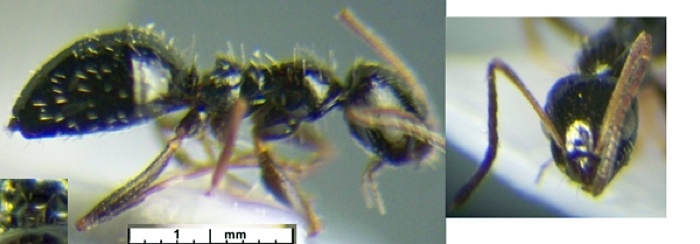 Petiole spines about half as long as their intervening
width; HW 0.60-0.61 SI 116 Petiole spines about half as long as their intervening
width; HW 0.60-0.61 SI 116
Specimen from Sudan
|
carbonaria |
| -- |
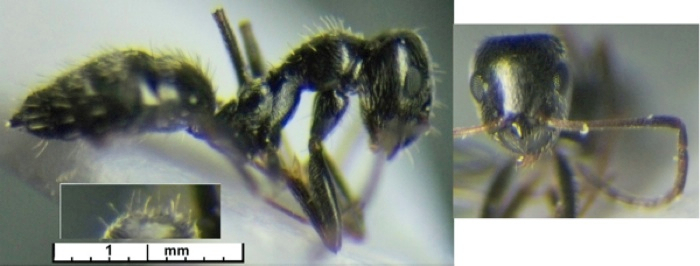 Petiole spines about half as
long as their intervening width or less, scale narrow apically in
profile; with abundant variably long erect white hairs on all surfaces;
distinctive downcurved hairs on clypeus - not Saudi Arabia Petiole spines about half as
long as their intervening width or less, scale narrow apically in
profile; with abundant variably long erect white hairs on all surfaces;
distinctive downcurved hairs on clypeus - not Saudi Arabia
With somewhat longer erect hairs on the pronotum,
general
pilosity
is shaggier, with abundant pubescence on the gaster; head in full face
view with a more rectangular appearance; the mandibles often concealed
when closed; eyes distinctly convex and protruding; overall appearance
shinier and blacker, eyes viewed from most angles seem to be black
|
hirsuta |
| 4 |
 Petiole dentate; coarse dorsal
sculpture especially on pronotum not obscuring cuticular shine; one or
two occasional pronotal hairs; HW 0.62 SI 112-113; Emery (1897e) erect
hairs on gaster confined to apical row on each tergite; pubescence more
copious than other carbonaria; almost all of body sub-opaque,
metanotum and propodeum opaque Petiole dentate; coarse dorsal
sculpture especially on pronotum not obscuring cuticular shine; one or
two occasional pronotal hairs; HW 0.62 SI 112-113; Emery (1897e) erect
hairs on gaster confined to apical row on each tergite; pubescence more
copious than other carbonaria; almost all of body sub-opaque,
metanotum and propodeum opaque
Specimen from Sudan
|
depilis |
--
|
 Petiole dentate; sculpture fine but visible; TL 3.2-4 mm; shiny; Tunisia Petiole dentate; sculpture fine but visible; TL 3.2-4 mm; shiny; Tunisia
|
pubescens |
Species with the head and gaster smooth and brilliant
| 1 |
 Covered with fine, sharp,
whitish hairs; TL max 2.5 mm; petiole spines weak (?) less
developed than type (capensis) but clear; ? petiole with
prolonged posterior pedicel. BT - head ovoid narrower anteriorly,
scapes darkened apically otherwise with funiculi brownish yellow; specimen from Sudan for comparison Covered with fine, sharp,
whitish hairs; TL max 2.5 mm; petiole spines weak (?) less
developed than type (capensis) but clear; ? petiole with
prolonged posterior pedicel. BT - head ovoid narrower anteriorly,
scapes darkened apically otherwise with funiculi brownish yellow; specimen from Sudan for comparison
|
canescens |
| -- |
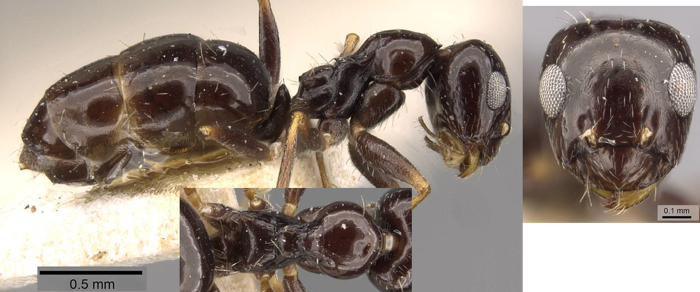 very few erect hairs on alitrunk;
for comparison; type location Somalia very few erect hairs on alitrunk;
for comparison; type location Somalia
|
simplex |
|